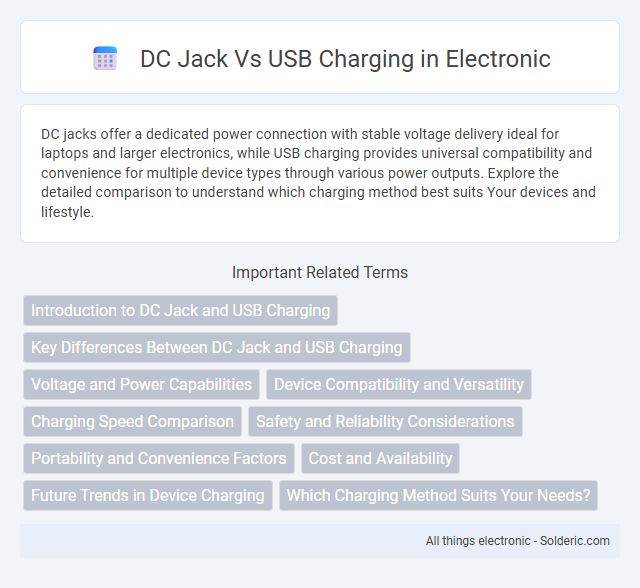DC jacks offer a dedicated power connection with stable voltage delivery ideal for laptops and larger electronics, while USB charging provides universal compatibility and convenience for multiple device types through various power outputs. Explore the detailed comparison to understand which charging method best suits Your devices and lifestyle.
Comparison Table
| Feature | DC Jack Charging | USB Charging |
|---|---|---|
| Voltage Supply | Varies (commonly 12V-24V) | Standard 5V (USB 2.0), up to 20V (USB-C PD) |
| Current Capacity | Higher current, supports fast charging and high power devices | Generally lower current; USB-C PD allows up to 5A |
| Compatibility | Device-specific connectors | Universal USB ports (USB-A, USB-C) |
| Portability | Less flexible; requires matched charger | Highly portable; common cables and chargers |
| Durability | Robust, less prone to wear | More wear from frequent plugging/unplugging |
| Power Delivery Standards | Manufacturer specific, no universal standard | USB Power Delivery (USB PD) supports dynamic power negotiation |
| Use Cases | Laptops, DSLR cameras, some routers | Smartphones, tablets, laptops, peripherals |
| Cost | Usually requires dedicated charger, potentially higher cost | Affordable, wide availability of chargers |
Introduction to DC Jack and USB Charging
DC jacks provide a dedicated power input that delivers consistent voltage and current, making them ideal for devices requiring stable and higher power supply. USB charging ports offer convenience and compatibility across multiple devices, utilizing standardized voltage with power delivery protocols to optimize charging speed and safety. Your choice between DC jack and USB charging depends on the device's power needs and portability requirements.
Key Differences Between DC Jack and USB Charging
DC jacks provide a dedicated power input with higher voltage and current capacity, ideal for laptops and larger electronics requiring stable power delivery. USB charging offers universal compatibility, lower voltage output (typically 5V), and convenience through multiple device support and data transfer capability. Your choice depends on device power requirements and the need for portability or fast, versatile charging options.
Voltage and Power Capabilities
DC jacks typically support higher voltages ranging from 12V to 24V, enabling them to deliver greater power levels suitable for demanding devices such as laptops and large electronic equipment. USB charging standards vary, with USB 2.0 providing 5V at up to 2.5W, USB 3.0 increasing power output to 15W, and USB Power Delivery (USB-PD) supporting voltages from 5V to 20V with power delivery up to 100W. The higher voltage and wattage capacity of DC jacks generally make them more suitable for devices requiring stable, high-power input, whereas USB charging offers flexibility and compatibility with a wide range of smaller devices.
Device Compatibility and Versatility
DC jacks are commonly found in laptops and larger electronics, offering compatibility with a wide range of devices requiring stable, higher voltage power input. USB charging provides greater versatility, supporting many modern gadgets, including smartphones, tablets, and some laptops, through standardized power delivery protocols. Your choice depends on the device's power requirements and the need for universal charging solutions.
Charging Speed Comparison
DC jack charging typically supports higher wattage input, allowing faster charging speeds for laptops and other devices compared to USB charging. USB charging speed varies significantly based on the USB standard; USB-C Power Delivery (PD) can reach up to 100W, approaching or matching some DC jack outputs but USB-A and older USB-C ports generally provide lower wattage. Devices relying on DC jack tend to benefit from consistent, high-speed charging, while USB charging offers versatility but may be limited by cable and power adapter specifications.
Safety and Reliability Considerations
DC jacks typically offer a more secure and stable connection, reducing the risk of short circuits and power surges, which enhances overall safety and reliability. USB charging ports, while convenient and widely compatible, may be more susceptible to wear and loose connections over time, potentially compromising consistent power delivery. Choosing a DC jack often ensures a more durable and reliable power interface, especially for high-power or sensitive electronic devices.
Portability and Convenience Factors
DC jack charging often requires a bulkier power adapter, making it less portable compared to USB charging, which uses compact and widely compatible cables. USB charging supports multiple devices with a single charger, enhancing convenience for travel and everyday use. Your device's overall portability improves significantly when relying on USB charging due to its lightweight and universal compatibility.
Cost and Availability
DC jacks are generally more cost-effective and widely available due to their long-established use in various electronic devices, resulting in lower manufacturing expenses and easier sourcing. USB charging ports, while sometimes pricier initially, benefit from universal compatibility and increasing prevalence in consumer electronics, which can offset costs through standardization and bulk production. The choice between DC jack and USB charging often depends on device design priorities and market demand, influencing component supply and pricing dynamics.
Future Trends in Device Charging
DC jack charging maintains reliability for high-power devices but is increasingly complemented by USB charging, which supports faster data transfer and broader compatibility. USB-C technology advances with enhanced power delivery standards, enabling quicker and more efficient charging for a wide range of gadgets. Your devices will benefit from the ongoing shift toward versatile USB charging solutions, promoting universal connectivity and convenience.
Which Charging Method Suits Your Needs?
Choosing between a DC jack and USB charging depends on device compatibility and power requirements; DC jacks typically provide higher voltage and current, ideal for laptops and power-hungry electronics. USB charging, especially with USB-C Power Delivery, offers versatility and convenience for smartphones, tablets, and lightweight devices through standardized connectors and widespread availability. Evaluate your device's power specifications and usage habits to select the charging method that ensures efficiency and safety.
DC jack vs USB charging Infographic

 solderic.com
solderic.com